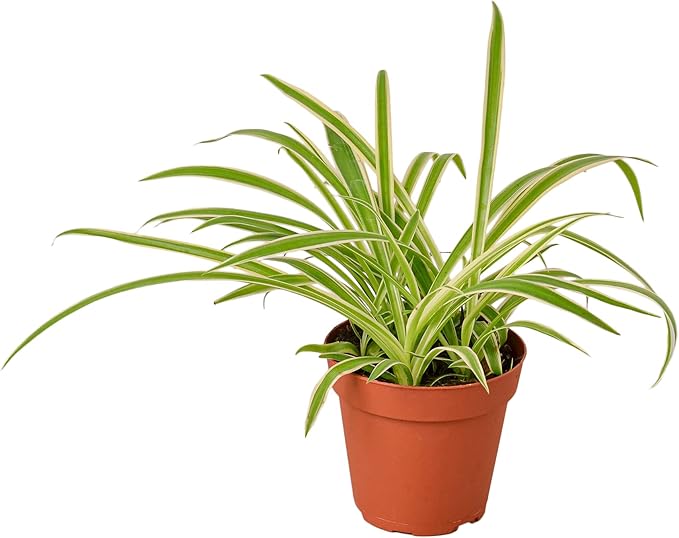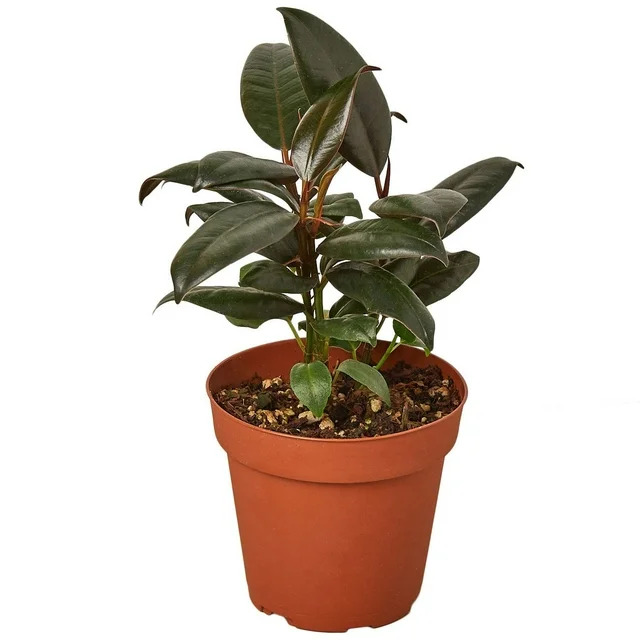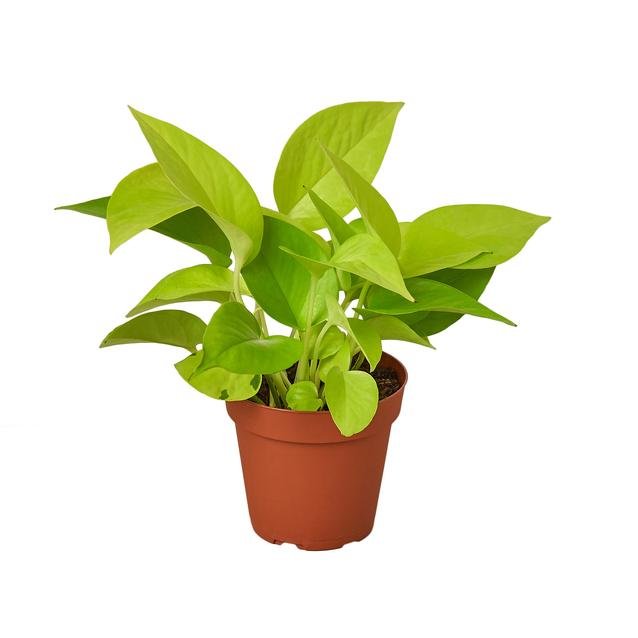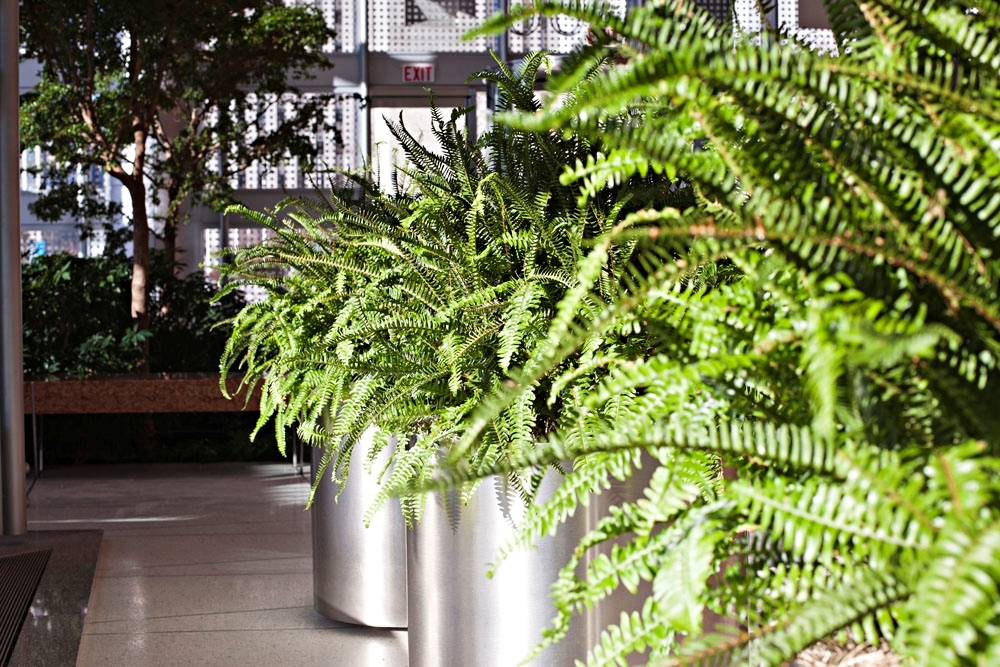National Indoor Plant Week Giveaway
We partnered with some of our property manager clients to host a plant giveaway in their lobbies in honor of National Indoor Plant Week. If you were one of the lucky recipients of one of our plants (they went really fast!), please see below for care instructions.

Spider Plant Care
The is a favorite among homeowners, offices, and interior designers alike. With its air-purifying qualities, sculptural look, and ease of care, the Spider Plant (Chlorophytum comosum) is a staple in modern interior plant design.
What Does a Spider Plant Look Like?
The Spider Plant is recognizable by its long, arching leaves, typically green with creamy white or yellow stripes. These striking variegated blades grow in a fountain-like shape, giving the plant a dynamic, flowing appearance. As it matures, the plant produces graceful trailing stems with baby spiderettes – miniature versions of itself that dangle below the main plant like leafy ornaments.
Its ability to soften edges and add movement makes it a popular choice in Chicago office greenery projects and home plant styling alike.
Lighting Requirements
Spider Plants are incredibly adaptable and well-suited to variable indoor lighting conditions.
- Ideal Light: Bright, indirect sunlight
- Tolerates: Moderate to low light
- Avoid: Prolonged direct sun, which can scorch the leaves
Chicago Winter Tip: Spider Plants remain happy with reduced light, but if natural daylight is sparse during the darker months, a full-spectrum LED grow light can help keep your plant vibrant.
Watering & Humidity Needs
Spider Plants prefer consistently moist—but not soggy—soil. Let the top inch dry between waterings. They’re forgiving of occasional neglect, which makes them ideal for beginner plant owners.
- Watering: Every 7–10 days, if needed; reduce frequency in winter
- Humidity: Prefers moderate humidity; tolerant of dry air, but browning tips may occur in dry, heated spaces
- Soil: Well-draining potting mix with perlite or coconut coir
Where Do Spider Plants Come From?
Native to tropical and subtropical South Africa, Spider Plants thrive in warm, humid forests. Their natural adaptability helps them flourish in modern indoor environments.
Fun Facts & Trivia
- Botanical Name: Chlorophytum comosum
- Spider Plants earned their name from their spider-like plantlets that dangle from long runners.
- They’re one of the top houseplants in NASA’s Clean Air Study for removing formaldehyde, carbon monoxide, and xylene from the air.
Are Spider Plants Pet-Friendly
Yes! They are non-toxic to cats and dogs.
Pruning, Growth, and Propagation
Spider Plants grow fast and benefit from regular grooming:
- Trim off brown leaf tips and spent runners to keep a tidy shape.
- To propagate, snip off spiderettes once they have tiny roots and pot them in moist soil.

Ficus Elastica ‘Burgundy’ Care
The Ficus elastica ‘Burgundy’, also known as the Burgundy Rubber Plant, is a striking, low-maintenance indoor tree that adds bold structure and rich color to any space. With its deep, almost black leaves and sculptural presence, it’s a favorite for modern Chicago commercial interiors.
If you’re looking for a statement plant that combines a dramatic look, air-purifying benefits, and easy care, the Burgundy Rubber Plant is a top choice for interior plant design in Chicago.
What Does a Ficus Elastica ‘Burgundy’ Look Like?
This elegant plant features large, leathery, oval-shaped leaves in a rich burgundy to dark green hue, often with a subtle purplish tone and a deep red midrib. New growth emerges in a stunning reddish sheath before unfurling. Its upright form and glossy foliage make it perfect for:
- Corners of living rooms or offices
- Architectural accents in entryways
- Design-forward commercial spaces
Burgundy Rubber Plants bring a refined, moody look to interiors.
Light Requirements
Ficus elastica ‘Burgundy’ does best in bright, indirect light, which helps maintain its rich color and compact shape. It will also tolerate medium light, making it adaptable to many settings in Chicago interior plant design applications.
- Ideal Placement: Near a large window with filtered light
- Avoid: Prolonged direct sun, which can scorch leaves
- Low Light Effect: Leaf color may fade or growth may slow
Chicago Tip: Place near south- or west-facing windows during winter to compensate for lower light levels.
Watering & Humidity
The Burgundy Rubber Plant prefers moderate moisture but doesn’t like soggy soil. It’s important to avoid overwatering which can result in root rot.
- Watering Frequency: Every 7 – 10 days in growing season, if needed; less in winter
- Check Soil: Let the top 25 – 30% dry out before watering
- Humidity: Tolerates Chicago’s dry indoor air but thrives with occasional misting
- Soil: Use a well-draining mix with perlite or sand
Where It Comes From
Ficus elastica is native to tropical regions of Southeast Asia, including India, Nepal, and Indonesia. In its natural habitat, it can grow over 100 feet tall,
Fun Facts & Trivia
- Common names: Rubber Plant, Burgundy Rubber Tree, Indian Rubber Tree
- Historically used to extract natural rubber—though not the primary commercial source today
- Part of the Moraceae family, which includes figs and mulberries
- Featured in NASA’s Clean Air Study for its air-purifying qualities
- Symbolizes abundance, good fortune, and resilience in Feng Shui
Is the Ficus Elastica “Burgundy” toxic to pets.
Yes, the plant is not only toxic to pets, but also humans, if ingested due to the milky latex sap that can be found in all parts of the plant. Some people’s skin is sensitive to the sap. We recommend wearing gloves when pruning or washing your hands thoroughly and immediately after exposure to plants.
Growth & Maintenance Tips
- Rotate the plant regularly to promote even growth
- Wipe leaves occasionally to keep them dust-free and glossy
- Prune to maintain height and shape—new branches will grow from below cuts
- Repot every 2 – 3 years as it becomes root-bound

Pothos Neon Care
If you’re looking to add a pop of color and low-maintenance greenery to your home or office in Chicago, Pothos Neon (Epipremnum aureum ‘Neon’) is a vibrant, easy-care choice. With its chartreuse, electric-lime leaves and trailing growth habit, the Pothos Neon is a favorite for interior plant design.
What Does a Pothos Neon Look Like?
The Pothos Neon is known for its bold, bright yellow-green foliage that glows in natural light. Unlike its more mottled pothos cousins, this variety features uniform neon-colored leaves.
Lighting Requirements
This plant is happiest in bright, indirect light. It will tolerate low light conditions, making it an ideal plant for Chicago apartments or offices with minimal sunlight. However, the more light it receives (without direct sun exposure), the more vibrant its leaves will appear.
Pro Tip for Chicago Winters: Our Chicagoland winters have many short and cloudy days; consider placing your Pothos Neon near a north or east-facing window.
Watering and Humidity
Let the top 25-30% of soil dry out between waterings. During our dry winter, consider misting your plant or placing it near a humidifier to prevent crispy edges on leaves.
- Watering Frequency: Every 7-10 days in spring/summer, if needed; reduce in winter
- Humidity: Average home humidity is fine, but higher is better
- Soil: Well-draining potting mix with perlite or orchid bark
Fun Facts & Trivia
- Native Habitat: Tropical regions of Southeast Asia and the Solomon Islands
- In the wild, pothos can climb over 30 feet!
- The Neon Pothos is part of the Araceae family, which includes philodendrons and peace lilies.
- This plant is sometimes confused with the Lemon Lime Philodendron, but its leaves are more pointed and waxy.
Is Pothos Neon Pet Friendly?
No. Like all Pothos varieties, Pothos Neon is toxic to pets if ingested.
Pruning and Propagation
Pothos Neon is easy to propagate in water. Cut a stem with at least 2-3 nodes and submerge in a jar of water. Roots typically develop within a few weeks. Prune regularly to encourage fullness and prevent legginess (spindly stems, with little foliage that has a tendency to fall over).








